Traditional Cassoulet
In Search of the Languedoc Holy Grail
By Bradley Gray, special contributor to Grapelive.com
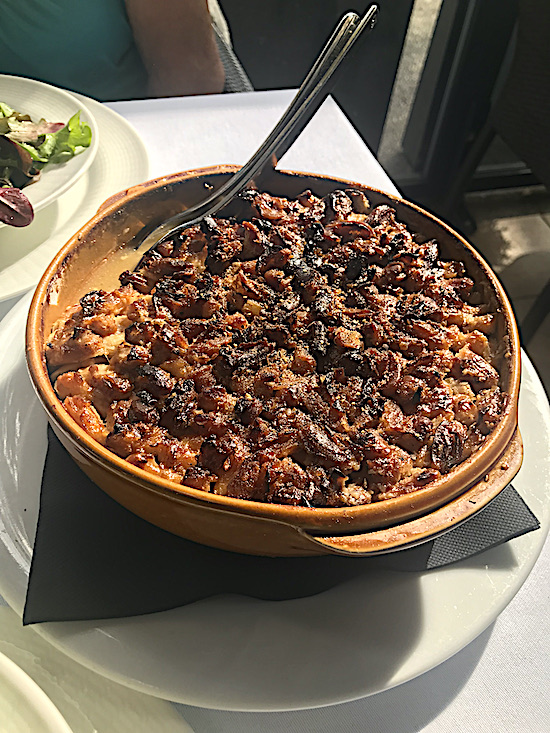
Cassoulet is undeniably the most delicious comfort food on the planet. This is a centuries-old peasant dish that I’ve been attempting for a mere decade, and with each uniquely different try – most were tasty – it was clear that I wasn’t getting it right. I travelled to the home of Cassoulet: the Languedoc region of Southern France. I met chefs, ate Cassoulets, and now I have a newly defined picture of what “traditional” Cassoulet is. I wanted to understand what Cassoulet is meant to be, directly from the source.
Cassoulet is a dish of legend which begins during the 100 Years War circa 1375. The British had surrounded the small village of Castelnaudary and were basically trying to starve the residents into surrender. Villagers gathered what food they had, cooked it in a cauldron, and fed it to the local forces. Folklore says it provided the soldiers with ample energy to drive the enemy away. It has always been a peasant dish: a stew of beans, sausage and local meats. The word “Cassoulet” comes from the terra cotta vessel it’s served in, the “cassolle” made by local potters. My goal was to learn how to re-create what I enjoyed where Cassoulet was born.
This dish is revered with great passion in Toulouse, Castelnaudary and Carcassonne, the three neighboring villages that hold claim to Cassoulet. Today, there is an honor bestowed on the finest Cassoulet restaurants: Grande Confrérie du Cassoulet de Castelnaudary (the Grand Brotherhood of Cassoulet of Castelnaudary). This alliance, formed in 1970, focuses on protecting the integrity of the dish. Although regional cassoulets can vary (in Toulouse, you may find lamb or mutton, while in Carcassonne, goose or partridge may be ingredients), I’m sticking with Castelnaudary style, with duck confit and Toulouse style sausage (all of the restaurants I visited in Toulouse, Castelnaudary and Carcassonne served this style).
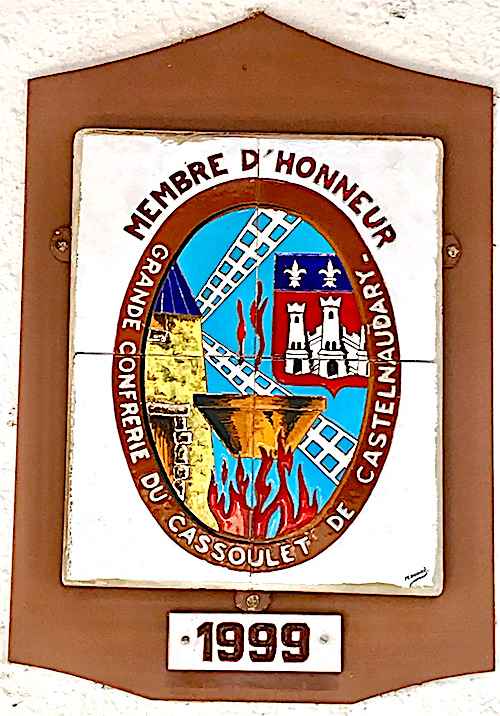
I began in Toulouse which is the cultural center of the Languedoc. I dined at Maison Du Cassoulet, which is a local favorite founded in 1956. I was immediately struck at how different Cassoulet was here compared to the recipes I had followed previously. There were no signs of any tomatoes or bread crumb toppings, the pork sausage was in one piece (rather bite size pieces) and quite mild, and the broth surrounding the beans was very rich and almost clear. In fact, this was the case with every cassoulet I ate, and I tried a bunch! Maison Du Cassoulet also has locations in Castelnaudary and Carcassonne. Delicious isn’t even a good enough word. They gave me a really cool hat. (see in my bio)
The next day, it was a quickie train ride to Castelnaudary – the birthplace of Cassoulet! After a hike from the train station, I had a wonderful Cassoulet at Le Centre Restaurant, in the heart of the small historic village. This establishment was more elegant than Maison Du Cassoulet, and their offering was excellent. It was rich and hearty, and the “crust” on top of their Cassoulet was magnificent.

Carcassonne is a simply amazing city, just a stone’s throw down the tracks from Castelnaudary. It’s a community within the walls of a huge medieval fortress and castle on a hilltop. On this evening, it was Adelaide, a famous Cassoulet restaurant I’d sought out before my trip. It was inside the walls of the fortress, and words can’t describe Carcassonne or it’s charm. Their Cassoulet was presented a little differently than the previous ones, with the duck confit and sausage floated on top of the casserole. It was spectacular. And delicious.
Then there was the Cassoulet at La Trivalou, a tiny cafe in Carcassonne. Before my trip, I researched the best restaurants for Cassoulet, and this was touted to be the best in the Languedoc by multiple websites. And it was! Just under the drawbridge of the majestic castle, this little restaurant was all about the chef, and nothing else. The ambience was so-so, it was a small cafe where the food did all of the talking!
Le Trivalou
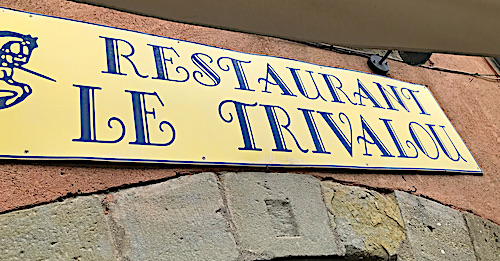
The starter was delicious yet untraditional escargot in cauliflower, and the Cassoulet was not only visually stunning, it was the tastiest by far. Chef Cyril Requi spent time talking to me,
and although there were language challenges (I don’t speak French), I did understand what he was saying. I have read recipes that say you need to cook Cassoulet for 3 days, breaking the “crust” a minimum of seven times. The last time I tried that, it tasted burnt, but I wasn’t using duck fat or duck stock, and my oven was too hot. Honestly, I really didn’t know what I was trying to create. Requi says that after the Cassoulet is assembled, cook it at two hours at a simmer max. He also said something about adding foie gras, but I didn’t completely understand. The thing about the La Trivalou Cassoulet that set it apart from the others is that it’s flavors were focused, clean, super pronounced and it was so creamy.
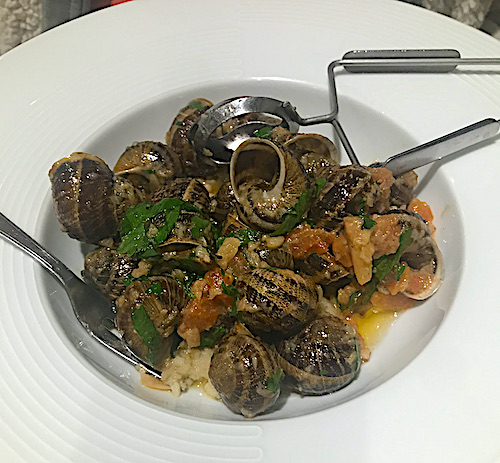
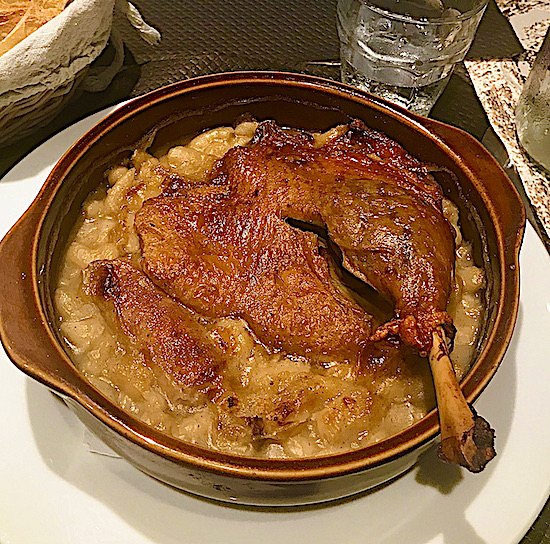
Online domestic websites and recipes (including the Julia Child’s version of Cassoulet) call for ingredients I didn’t see in Languedoc Cassoulets: tomatoes, bread crumbs (to create a fake crust), spicy sausage, chicken, salami (?), beef and beef sausage. I’ve seen recipes that call for chorizo, bacon, etc. No wonder my previous attempts didn’t quite have it!
Cassoulet might be made with goose, pork shoulder or partridge, but all of the Cassoulets I had in “the home of Cassoulet” included the same main ingredients: very mild Toulouse style sausage served in one piece, duck confit, duck stock, rendered duck fat, salt pork lardons (not bacon), Tarbais beans, carrot, onion, celery, etc.
All of that said, I am not a soup Nazi. If you are thinking about making Cassoulet, it is a peasant dish, and wide open to improvisation. Here, I am only trying to understand the dish in its purity, and share my experience. I mentioned above I’ve been attempting to make cassoulet for years before this trip, and they were mostly all wrong but each uniquely delicious.
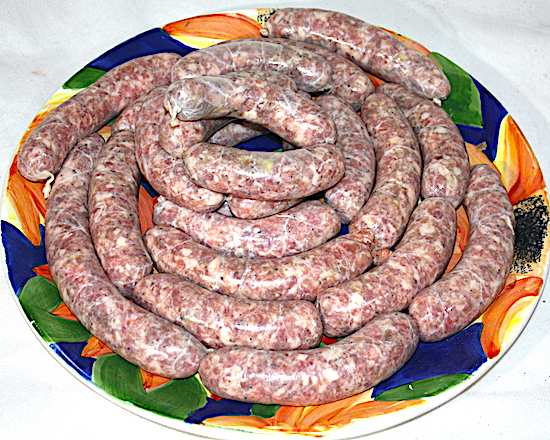
Recipes I have followed in the past called for the wrong sausage. Julia Child’s cassoulet calls for Kielbasa or Chorizo, and both are too spicy for “traditional” cassoulet. Toulouse style sausage is not available locally in Sonoma or online. In the past, I’ve used mild Italian sausage, but the fennel, basil, paprika and other spices have clashed with the Cassoulet. The only ingredients in Toulouse sausage are ground pork, pork belly, garlic, pepper and a small pinch of nutmeg. With Toulouse sausage, the meat flavors shine, rather than the heavy dose of seasonings found in other sausages. I asked Jeremy, the butcher at Sonoma Market what he recommended, and I sure didn’t expect the answer he gave me: “Make it yourself!” So, with a few tips from him, I did exactly that with a $10 sausage stuffer from Amazon and a couple Youtube tutorials. There’s a first time for everything!
If you are up to making your own Toulouse sausage (it’s not very hard or expensive), there is a good recipe here. I found that this recipe made way more sausage than I needed, so I suggest cutting it in half. Ask your local butcher to grind the pork and pork belly coarsely:
Toulouse Sausage
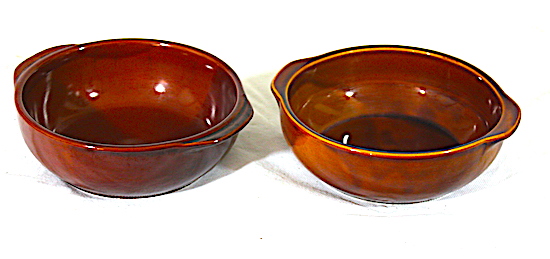
Presentation is important, and finding the correct dish for Cassoulet isn’t easy. The “cassolle” terra cotta dish is the right one. They don’t exist in the US for under $50, mostly from artisan potters. Le Creuset and others make Cassoulet bowls. They aren’t traditional, but pretty. Chef Cyril Requi (Le Trivalou) sent me home with two authentic bowls from his restaurant. In Languedoc, brown earthenware oven-safe bowls are used, but go with what you have!
After this enjoyable and eye opening visit to the Languedoc, I once again attempted to create Cassoulet, but this time, I had a focused understanding of what I was aiming for, both flavor-wise and visually. I did face some ingredient problems: Toulouse style sausage I discussed above. Traditional Tarbais beans are available online here for $20 per pound. I used great northern beans and saved $19. Duck stock is not available here. I purchased a duck carcass from a local duck company and made my own. If not for the duck company, I would have used chicken stock, which is do-able. Duck confit is available at upscale grocers, along with duck legs. Prepared confit is expensive, so I bought the duck legs and did the confit myself. Instructions are online.
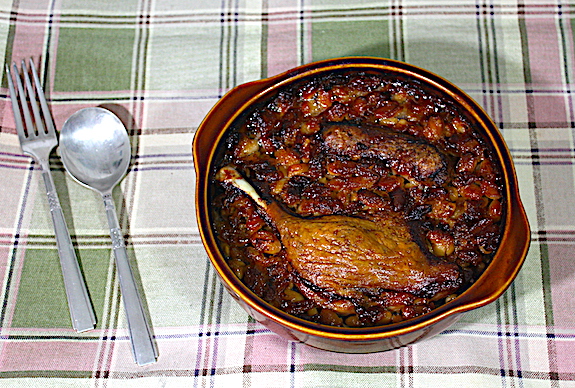
The “crust” on the top of Cassoulet is part of its magic, and no, contrary to American urban myth, it’s not done with bread crumbs. The crust is the gelatinous part of the stock, which rises to the top when cooked. It’s easy to achieve this crust, even if you are using store-bought chicken stock. The crust comes from slow cooking. Part of the Cassoulet tradition is cooking, then refrigerating overnight, and cooking again. This allows the crust and melded flavors to develop.
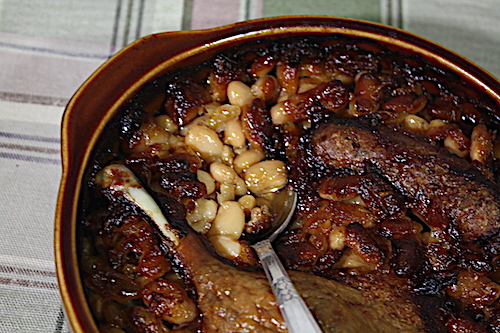
This time, I tried to do it right. The results were spectacular, and the flavor was exactly what I reminisce from France! You’ll never catch me preparing a Cassoulet with tomatoes, spicy sausage or beef, and I’ll NEVER add bread crumbs to the top, ever (again). Promise!
Enjoy Cassoulet on a blustery or cold evening with a green salad, a baguette and a Languedoc wine. See Kerry’s Grapelive.com suggestions below.
Cassoulet does take time and patience to make. Plan on a couple days, though for most of this, you won’t have to babysit it. As with most French recipes, cutting corners only diminishes the shine. If you do make it, don’t rush it!
Cassoulet Recipe
